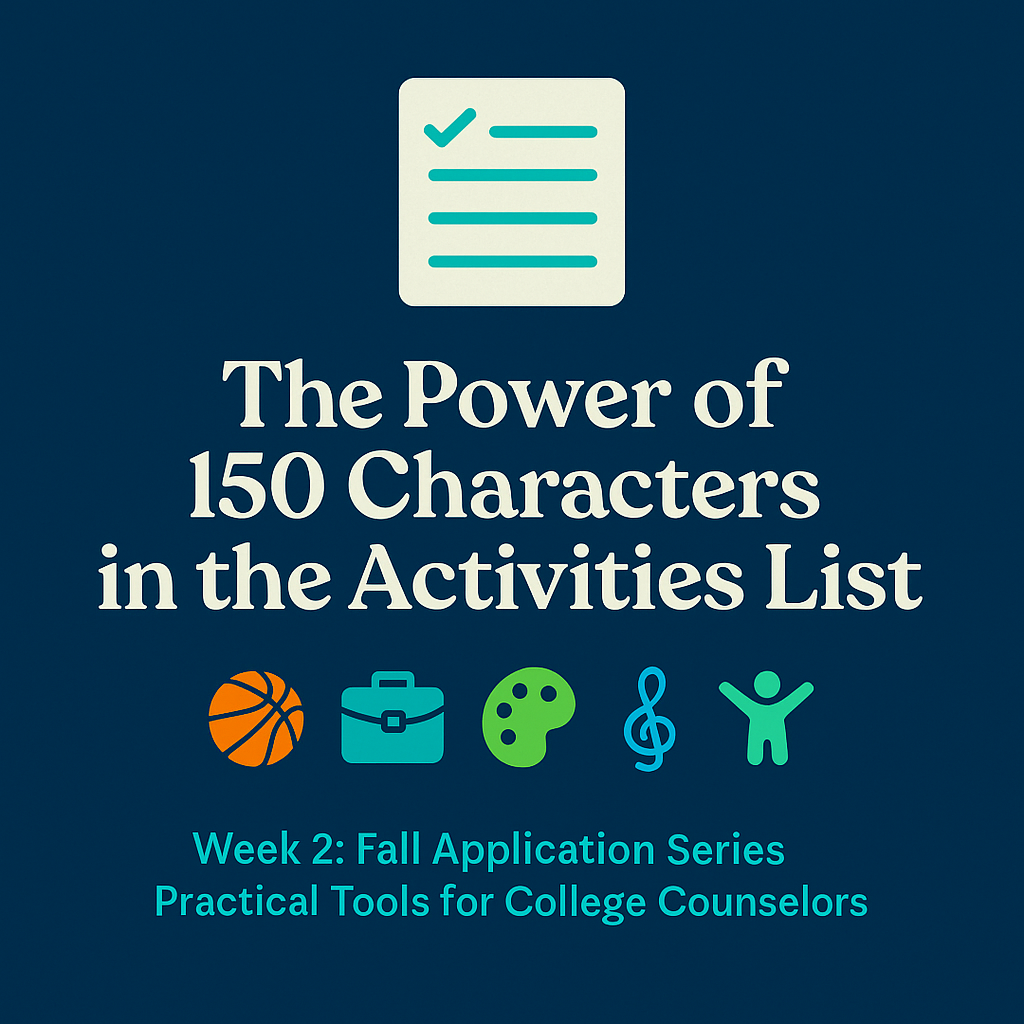Introduction
For too many students, the Activities List can be treated like an afterthought and they seem to pour the large majority of their energy into their essays. The Activities List can mistakenly be seen as a series of short blurbs to fill in before hitting submit. But for admissions readers, it’s often the first (and maybe the most helpful) way to understand who a student really is.
In my opinion, the Activities List is a place where counselors can add enormous value by helping students identify what they’re leaving out, focus on what’s meaningful, and make every word count.
- Make Sure Students Include Everything
Students tend to focus on the generic idea of extracurriculars like sports, clubs, or service. But some of the most telling experiences happen outside those lines and I always ask students about some things they may have overlooked. Encourage students to think about:
- Jobs: part-time or seasonal work, babysitting, family business
- Family responsibilities: caring for siblings or elders, helping with translation, managing household needs
- Creative work: photography, writing, crafts, digital art, performance, design
- Independent projects: blogs, YouTube channels, community events, small businesses
- Faith or cultural roles: youth group leadership, event planning, mentoring younger members
- Everyday passions: training pets, restoring cars, streaming content, gardening, or anything that shows curiosity and commitment
If it takes effort, builds skills, or shows character.. it belongs. Students just think that this is something they are into without realizing colleges want to hear about that.
2. Focus on the Experience, Not the Definition
Students often describe what they did instead of how they did it.
“I played point guard,” “Went to Bible study,” “Attended chess club.”
All of that is already implied: You can put Point Guard as part of the Position/Description. If you’re in the chess club, readers already assume you attended chess club. Use the 150 characters to explain how the student showed up in that role:
- “Team captain; ran warm-ups and mentored underclassmen.”
- “Planned youth service events and led small-group reflections.”
- “Organized weekly chess matches and taught beginners strategy.”
Counselor tip: Ask, “If someone outside your school read this, would they understand what makes it meaningful?”
3. Make Every Word Earn Its Place
Space is limited, so clarity is everything. Encourage students to start with strong verbs and skip filler words like “helped,” “worked on,” or “participated in.” They don’t even need to use complete sentences as long as the reader can understand the phrase. Compare these examples to see the difference:
Weak: I worked at my family’s store and I did a lot of various math.
Better: Managed family store finances; balanced weekly cash reports.
Weak: I helped with making multiple club social media posts to attract new members
Better: Designed and ran social media campaign; doubled club membership.
Here are two resources that could be helpful:
1. Some Tips for Reviewing Students’ Activity Descriptions
— Start with a verb (led, created, designed, managed, built, coached).
— Cut filler: replace “helped with” → “organized,” “worked on” → “produced.”
– Use numbers or results when possible (“raised $500,” “taught 8 peers”).
— Avoid restating the obvious (“played flute,” “attended meetings”).
— Focus on impact, growth, or initiative over position title.
— Read out loud… if it sounds like something you’d say naturally, it’s probably clear.
— Remind students: you only get 150 characters, but you can fit a lot of story into that space.
2. Simple Résumé Template for Students
Some students run out of room on the Common App… or don’t use it at all. A short résumé helps capture everything clearly and gives counselors and recommenders a fuller picture. This is just a template to get them going and certainly not the only way to format it. Whether they use this template or something else, they should reformat it and add a little color or font to make it their own and reflect their style and personality.
Header
Name
Email • Phone • City, State • Graduation Year
Education
School Name; City, State
(Expected Graduation: Month Year)
GPA: ___ | Class Rank: ___ | Coursework Highlights: ___
Activities & Involvement
• [Organization Name]; [Role or Title], [Dates]
Brief description (1–2 lines) focusing on leadership, initiative, or outcomes.
• [Activity Name]: [Role or Title], [Dates]
Add impact: numbers, results, or unique contributions.
Work & Service
• [Employer/Organization]: [Position], [Dates]
Brief description showing reliability, responsibility, or skill development.
Honors & Awards
List around to 3–8 with short context if not self-explanatory.
Skills or Interests
Optional to highlight relevant or personal interests that show depth or personality.
Closing Thought
The Activities List isn’t about filling boxes. It’s about capturing and retelling who they are and what they did with their time. As counselors, we understand the importance of the Activities section, but many students save it until the very end and don’t give it the time, thought, and effort it deserves. When counselors help students identify overlooked experiences and describe them with focus and economy, they teach one of the most valuable lessons in the process: your story already matters and you just have to tell it clearly.

